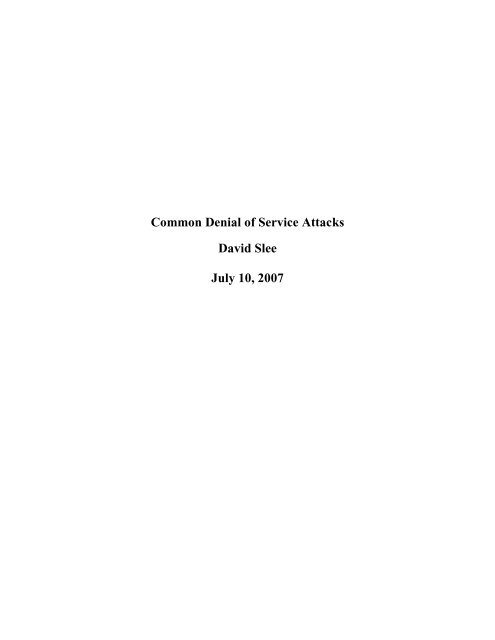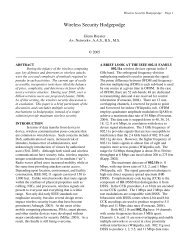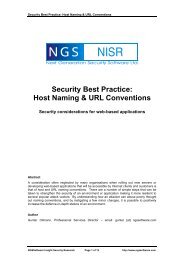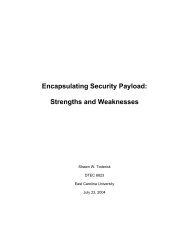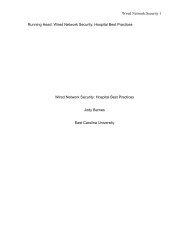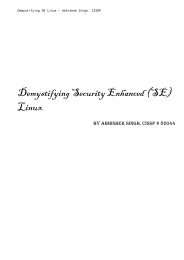Common Denial of Service Attacks - Infosecwriters.com
Common Denial of Service Attacks - Infosecwriters.com
Common Denial of Service Attacks - Infosecwriters.com
You also want an ePaper? Increase the reach of your titles
YUMPU automatically turns print PDFs into web optimized ePapers that Google loves.
<strong>Common</strong> <strong>Denial</strong> <strong>of</strong> <strong>Service</strong> <strong>Attacks</strong><br />
David Slee<br />
July 10, 2007
Abstract<br />
This paper will examine various denial <strong>of</strong> service attacks and network defense<br />
measures taken against them. A historical look at the evolution <strong>of</strong> these attacks from<br />
different flood attacks to zombie driven botnet attacks will shed light on their<br />
increasingly more sophisticated design and the networking <strong>com</strong>munity efforts to <strong>com</strong>bat<br />
them. The current technology, motivation and future trends <strong>of</strong> distributed denial <strong>of</strong><br />
service botnet attacks will be also be presented.
Introduction<br />
<strong>Denial</strong> <strong>of</strong> service attacks <strong>com</strong>e in two types: <strong>Denial</strong> <strong>of</strong> <strong>Service</strong> attacks (DoS) and<br />
Distributed <strong>Denial</strong> <strong>of</strong> <strong>Service</strong> attacks (DDoS). A DoS attack is "an attack in which a<br />
third party purposely floods a network or website with traffic in order to prevent<br />
legitimate access (“<strong>Denial</strong> <strong>of</strong> <strong>Service</strong>”, 2007)". A DDoS "occurs when multiple<br />
<strong>com</strong>promised systems flood the bandwidth or resources <strong>of</strong> a targeted system, usually<br />
one or more web servers (“<strong>Denial</strong>-<strong>of</strong>-service attack”, 2007)." In both cases, system<br />
vulnerabilities, hardware and/or s<strong>of</strong>tware, are exploited to allow an intruder to<br />
<strong>com</strong>promise a system. Today, DDoS attacks carried out by “botnets”, take advantage <strong>of</strong><br />
multiple <strong>com</strong>promised personal <strong>com</strong>puters, or “zombies”, to direct a coordinated attack<br />
on a target network. Early DoS attacks are well known and can be defended against by<br />
robust networking equipment and proper security practices.<br />
DDoS botnet attacks <strong>of</strong><br />
today present a more difficult challenge for network administrators. The perpetrators <strong>of</strong><br />
botnet attacks have found it to be a very lucrative practice and are constantly evolving<br />
their methods as new vulnerabilities arise. A very large botnet can overwhelm the best<br />
<strong>of</strong> defenses. The motivation for botnet attacks vary from extortion to corporate warfare<br />
to nationalistic pride. The creators <strong>of</strong> botnets can be very organized and treat their<br />
endeavor as serious business. Fortunately, it appears the awareness <strong>of</strong> the information<br />
security <strong>com</strong>munity has reached critical mass in the last few years as many botnet<br />
detection and prevention tools have begun to appear in the market from the likes <strong>of</strong><br />
Google, Tumbleweed and Cisco.
DoS <strong>Attacks</strong><br />
The most <strong>com</strong>mon type <strong>of</strong> DoS attack occurs when a network is flooded with<br />
data sent by an attacker. For example, a web server sent more requests than it can<br />
handle at once be<strong>com</strong>es overloaded. Once it is overwhelmed, it cannot process ordinary<br />
requests from anyone that might type a URL for a web site it is hosting. In this way, a<br />
user is denied service because he cannot access that site (McDowell, 2004). Any<br />
network device is fair game for an attack. Web, electronic mail and Domain Name<br />
System (DNS) servers and routing devices are all targets with known vulnerabilities for<br />
attackers to exploit. A DoS attack can be perpetrated in a number <strong>of</strong> ways. There are<br />
three basic types <strong>of</strong> attacks (“<strong>Denial</strong>-<strong>of</strong>-service attack”, 2007) :<br />
1. consumption <strong>of</strong> <strong>com</strong>putational resources, such as bandwidth, disk space, or CPU<br />
time;<br />
2. disruption <strong>of</strong> configuration information, such as information;<br />
3. disruption <strong>of</strong> physical network <strong>com</strong>ponents.<br />
A DoS attack may include execution <strong>of</strong> “malware” intended to:<br />
• max out the CPU’s usage, preventing any work from occurring;<br />
• trigger errors in the microcode <strong>of</strong> the machine;<br />
• trigger errors in the sequencing <strong>of</strong> instructions, so as to force the <strong>com</strong>puter into an<br />
unstable state or lock-up;<br />
• exploits errors in the operating system to cause resource starvation and/or<br />
thrashing, i.e. to use up all available facilities so no real work can be<br />
ac<strong>com</strong>plished;
• crash the operating system itself<br />
Malware is s<strong>of</strong>tware used by a hacker designed to gain access, not purposefully<br />
permitted by a user, to a <strong>com</strong>puter and instruct the <strong>com</strong>puter to perform a task for the<br />
hacker.<br />
Trojans, spyware, adware, keyloggers, dialers, rootkits, botnets, crimeware,<br />
badware, viruses and worms are all types <strong>of</strong> malware.<br />
The purposes for writing malware<br />
include financial gain, espionage, revenge, anger, recognition or just to see how fast it<br />
might spread (“What is Malware?”, 2007).<br />
A Transmission Control Protocol (TCP) SYN flood is a type <strong>of</strong> DoS that falls under<br />
the category <strong>of</strong> consumption <strong>of</strong> <strong>com</strong>putational resources. In a TCP SYN flood attack, a<br />
machine is overloaded with TCP connection requests <strong>com</strong>ing in faster than it can respond<br />
to them. “SYN” refers to a TCP header synchronization flag (Whitman & Mattord, 2004).<br />
Each SYN packet contains a random, or “spo<strong>of</strong>ed”, source IP address. The SYN requests<br />
a new connection to the target machine from the phony IP address. A machine responds<br />
to the bogus IP address and waits for a response for a few minutes. The target’s<br />
connection table is consumed with requests that are never acknowledged. New<br />
connection requests from friendly users are ignored and denied access to the machine.<br />
Fortunately, SYN floods usually do not bring down server machines and a server will<br />
most likely return to normal once the attack stops. Although they are still vulnerable,<br />
improved operating systems do make it harder for SYN attacks to flood their connection<br />
tables (“SYN Flood”, 2007).<br />
Defensive techniques include micro blocks, SYN cookies, RST cookies and stack<br />
tweaking. Using micro blocks takes up less memory by not creating <strong>com</strong>plete connection<br />
objects which is what causes a memory failure. A SYN cookie cryptographic value is
included in a SYN response to the sender. If the sender is for real, the acknowledgement<br />
from the sender will include the cryptographic value. A connection is only established,<br />
and memory allocated, after a proper acknowledgement. An RST cookie, or packet,<br />
should be returned to a machine by a sender, when a faulty acknowledgement from a<br />
machine is sent in response to the original SYN packet. If no RST is returned, then the<br />
sender’s connection request is dropped and table resources are never used. Stack<br />
tweaking involves dropping random SYN packets and reducing the timeout <strong>of</strong> a<br />
connection request. Dropping random packets should cause the same sender to resend<br />
packets after a period <strong>of</strong> time. Shortening the timeout for a connection request frees up<br />
memory faster, mitigating the effect <strong>of</strong> a SYN attack (“SYN Flood”, 2007). Decreasing<br />
the memory allocated for each connection request and checking the in<strong>com</strong>ing route<br />
against the outgoing route <strong>of</strong> a new sender may <strong>of</strong>fer the best solution to attempted SYN<br />
flooding (Whitman & Mattord, 2004).<br />
A SYN flood can be used in a Man-in-the-middle TCP hijacking attack. In 1994,<br />
renowned hacker Kevin Mitnick used SYN flooding to prevent a system from<br />
transmitting. He then used TCP hijacking to assume the identity <strong>of</strong> the flooded system<br />
(Cotter, 2002). A TCP hijacking attack targets an existing connection between two<br />
machines and convinces the victim machine that a man-in-the-middle machine is the<br />
target machine. “Sniffing is the use <strong>of</strong> a network interface to receive data not intended for<br />
the machine in which the interface resides…Sniffers and hijacking s<strong>of</strong>tware are the basic<br />
tools used to mount hijacking attacks ( * de Vivo, de Vivo, & Isern, 1998).” It is<br />
possible to use s<strong>of</strong>tware like HUNT to perform sniffing, MAC address collection, ARP<br />
spo<strong>of</strong>ing and DNS spo<strong>of</strong>ing to mount a successful TCP hijack, (“Hunt, TCP Hijacking
Tool”, 2002). ARP stands for the Address Resolution Protocol responsible for translating<br />
IP addresses into MAC addresses. ARP creates a cached table <strong>of</strong> addresses. This table is<br />
updated whenever a system receives a response, whether it was requested or not. An<br />
attacker can tell system ‘A’ that it is system ‘B’ and begin receiving system B’s data<br />
(“Guide to ARP Spo<strong>of</strong>ing”, 2004). A DNS server is responsible for translating host<br />
names to IP addresses. DNS spo<strong>of</strong>ing involves impersonating a valid DNS server by<br />
sending invalid DNS responses to a client requesting a host name, or domain name,<br />
resolution. The Windows XP DNS resolver is known to have this vulnerability (* Green,<br />
2005). It should be noted that hijacking tools like Hunt can be legitimately used for testing<br />
system vulnerabilities.<br />
TCP hijacking attacks can be well defended by applying the latest network system<br />
security patches, implementing intrusion detection systems and properly configuring<br />
firewalls. Using encrypted connections is a best practice in mitigating TCP hijacking attacks.<br />
Even if a connection is hijacked, an attacker will not be able to make much use the encrypted<br />
connection packet data (Whitman & Mattord, 2004).<br />
ICMP attacks include a ping <strong>of</strong> death, ping floods, and a smurf attack. A ping <strong>of</strong> death<br />
attack is very easy to administer. All that needs to be done is to issue an ICMP Echo<br />
Request, a ping <strong>com</strong>mand, specifying an IP packet size greater than 65536 bytes e.g. ping<br />
–l 65510 . Vulnerable systems will crash when attacked with this<br />
<strong>com</strong>mand. An IP packet greater than 65535 bytes is illegal, but is fragmented into<br />
smaller parts when sent to a victim. The victim machine will attempt to reconstruct the<br />
fragments and create a buffer overflow eventually causing some systems to <strong>com</strong>e to a<br />
halt.<br />
Windows 95 and Windows NT used to allow this and were vulnerable to ping <strong>of</strong><br />
death attacks themselves. Any protocol sending an IP datagram can exploit this problem.
TCP, UDP, NFS, Telnet or HTTP are all potential vehicles for delivering malformed IP<br />
datagrams and any open listening port may be a target (Kenney, 1997). Today most<br />
operating systems do not allow the execution <strong>of</strong> a ping <strong>com</strong>mand with an IP packet<br />
beyond the maximum size limit and most networking devices have been patched to<br />
minimize this threat (Whitman & Mattord, 2004).<br />
A ping flood swamps a victim with ping packets consuming all <strong>of</strong> the victim’s<br />
<strong>com</strong>bined inbound and outbound bandwidth. It is a simple attack to administer e.g. ping –<br />
f . An attacker must have more bandwidth than the victim for the attack to succeed.<br />
Outbound bandwidth is exhausted by ping replies. Two possible firewall solutions to ping<br />
floods are 1) to only filter large ping packets and 2) delay the passing <strong>of</strong> ping request<br />
packets (“Ping Flood”, 2007).<br />
DDoS <strong>Attacks</strong><br />
A smurf attack is a variety <strong>of</strong> DDoS attack called an amplification attack. Network<br />
traffic is amplified through <strong>com</strong>promised systems before it reaches a victim <strong>com</strong>puter. A<br />
smurf attack ac<strong>com</strong>plishes this by flooding a victim <strong>com</strong>puter with ICMP echo and reply<br />
messages sent to one or more unprotected intermediary network broadcast addresses. The<br />
ping messages contain the spo<strong>of</strong>ed IP source address <strong>of</strong> the victim’s machine and <strong>com</strong>puters<br />
in the broadcast address domain will receive and reply to the ICMP echo messages. All <strong>of</strong><br />
the replies, which may be amplified by more than one broadcast domain and scores <strong>of</strong><br />
machines, will be sent to the victim’s machine exhausting its bandwidth and bringing it to a<br />
halt (* Kumar, Azad, Gomez & Valdez, 2006).
To defend against smurf attacks, all routers in a network must be configured to drop<br />
broadcast address ICMP echo requests. It is not good enough to configure a firewall router<br />
alone (Chau, 2004).<br />
A UDP flood or “fraggle” attack is another type <strong>of</strong> DDoS amplification attack. It relies on<br />
the UDP chargen and UDP echo services. These services are usually not used. Connecting to<br />
a UDP port running the chargen service produces a constant stream <strong>of</strong> data. A UDP port<br />
running the echo service simply bounces the packet back to the sender’s source address.<br />
Creating a UDP connection between chargen and echo ports will create a massive amount <strong>of</strong><br />
traffic between two machines. If a UDP packet is sent with a spo<strong>of</strong>ed source broadcast<br />
address to victim’s chargen port, multiple connections might be created between echo ports<br />
on machines in the spo<strong>of</strong>ed broadcast domain and the victim machine amplifying the amount<br />
<strong>of</strong> traffic targeting the victim (Wooding, 1998).<br />
These are the re<strong>com</strong>mended steps to protect a network from UDP flooding fraggle attack<br />
(“UDP Port <strong>Denial</strong>-<strong>of</strong>-<strong>Service</strong> Attack”, 1996):<br />
1) Disable and filter chargen and echo services.<br />
2) Disable and filter other unused UDP services.<br />
3) If you must provide external access to some UDP services, consider using<br />
a proxy mechanism to protect that service from misuse.<br />
4) Monitor your network.<br />
5) Take steps against IP spo<strong>of</strong>ing.<br />
Botnets<br />
When it <strong>com</strong>es to DDoS attacks, the current scourge <strong>of</strong> the Internet are DDoS attacks<br />
carried out by botnets. These networks are <strong>com</strong>prised <strong>of</strong> malware infected zombie<br />
personal <strong>com</strong>puters and can number in the millions (Keizer, 2005). Types <strong>of</strong> botnet
attack occur when a “zombie or bot source opens multiple TCP connections, and<br />
sometimes issues repetitive HTTP requests…[and]…low-rate zombie/botnet attacks,<br />
which are similar to bandwidth consumption attacks except that each attack source sends<br />
multiple requests at a low rate (“DDoS Mitigation <strong>Service</strong>s Based on Cisco Systems<br />
Clean Pipes”, 2007) ”.<br />
There a many types <strong>of</strong> malware that exploit operating system and<br />
browser vulnerabilities to turn a personal <strong>com</strong>puter into a zombie.<br />
Early DDoS attacks were done manually. “The attacker scanned remote machines for<br />
vulnerabilities, broke into them and installed the attack code, and then <strong>com</strong>manded the<br />
onset <strong>of</strong> the attack ( * Mirkovic, Martin & Reiher, 2005).” This process has evolved into<br />
something quite a bit more sophisticated. An example <strong>of</strong> this is Mpack, “a malware<br />
distribution and attack kit…sold by a Russian gang…and…<strong>com</strong>es <strong>com</strong>plete with a<br />
collection <strong>of</strong> exploit modules to be used out <strong>of</strong> the box (Lau, 2007)”.<br />
The largest botnet<br />
known to date consisting <strong>of</strong> about 1.5 million zombies was also linked to the “Russian<br />
Internet mafia” and was built to <strong>com</strong>promise and pillage online banking accounts. In this<br />
case, a Trojan horse called “Wayphisher” was created by a Dutch group <strong>of</strong> programmers<br />
(the leader was only 19 yrs old) and sold to the Russian mafia (Keizer, 2005).<br />
Typically botnets number in size from 10 to 100 zombies. A malicious botnet attack<br />
is carried out by the following steps (* Geer, 2005):<br />
1) a personal <strong>com</strong>puter is turned into a zombie by an e-mail attachment (with<br />
attached Trojan for example), infected web site or some other avenue<br />
2) the zombie pc will typically connect to a rogue IRC <strong>com</strong>mand and control server<br />
3) the server will then send instructions and <strong>com</strong>mands to the zombie
4) the zombie will awaken as a <strong>com</strong>ponent in a DDoS attack, a e-mail spammer or<br />
keystroke logger/password stealer<br />
Another type <strong>of</strong> botnet will use peer-to-peer s<strong>of</strong>tware to facilitate <strong>com</strong>munication<br />
between zombies. No central server is used which makes it much harder to detect. One<br />
zombie can initiate an attack on its own and pass the attack <strong>com</strong>mand on to the next<br />
zombie which will do the same until the entire botnet has been activated. If one zombie<br />
is discovered, it can alert other zombies to start infecting new machines to maintain<br />
their numbers (* Geer, 2005).<br />
The reasons for carrying out botnet attacks include extortion, corporate warfare, and<br />
nationalistic pride among others (including spam, pay per click abuse, keystroke logger<br />
and password theft ) (“What is a Botnet ?”, 2007). It is unclear how many botnets exist<br />
and how many website owners have been extorted. For example, a very pr<strong>of</strong>itable<br />
online gambling website located in the Caribbean or Central America might be<br />
attacked. The website owner will then be sent a pay<strong>of</strong>f demand in the amount <strong>of</strong><br />
thousands <strong>of</strong> dollars with the threat <strong>of</strong> repeating the attack. The website owner cannot<br />
afford much downtime before losing its clients to other gambling sites, so he pays <strong>of</strong>f<br />
the attacker. This is an embarrassing predicament and one that is underreported by<br />
many such victims (“DDoS Mitigation <strong>Service</strong>s Based on Cisco Systems Clean Pipes”,<br />
2007).<br />
<strong>Attacks</strong> on business rivals can be another motive for botnet attacks. One such attack<br />
was launched by the owner <strong>of</strong> an athletic apparel business on the website <strong>of</strong> a<br />
<strong>com</strong>peting business. In that case, the attacker was caught and sent to prison. In another<br />
case, an attack against security <strong>com</strong>pany Blue Security, which <strong>of</strong>fered free spam
prevention s<strong>of</strong>tware and a do-not-spam registry, resulted in Blue Security being<br />
ultimately overhelmed by a very large botnet. Homes with personal <strong>com</strong>puters with<br />
always on broadband connection haves accelerated the spread <strong>of</strong> botnets. The greater<br />
bandwidth <strong>of</strong> these connections allow for faster infection and more forceful DDoS<br />
attacks and spamming. The largest botnets out there <strong>of</strong> a million plus zombies can<br />
harness and direct an attack with a bandwidth <strong>of</strong> 22 to 24 Gbps. The largest <strong>of</strong><br />
websites, perhaps even one like Google, may be vulnerable to such an attack (Berinato,<br />
2006). Attempts at taking down the Internet itself, for boastful purposes one would<br />
presume, have occurred by attacking the Internet’s root servers (McMillan, 2007).<br />
However, an attack on Google would not be in the best interest <strong>of</strong> botnet operators as<br />
automated botnet pay per click abuse is a <strong>com</strong>mon and pr<strong>of</strong>itable practice for them.<br />
Botnets can be programmed to automatically click on Google AdSense banner ads<br />
creating revenue for website publishers and raising costs for advertisers (Leyden, 2006).<br />
Politics may also be the reason behind some botnet attacks. In Estonia,<br />
governmental websites were recently attacked because a Soviet era monument was<br />
moved to another location (Vamosi, 2007). Political party and new media websites in<br />
Russia were attacked as elections drew near (“Cyber attacks engulf Kremlin's critics”,<br />
2007). On the day <strong>of</strong> the Democratic primary in Connecticut, the website <strong>of</strong> candidate<br />
Joe Lieberman was attacked, most likely by a botnet (Sullivan, 2006).<br />
Defensive measures against botnet attacks fall into the preventive and reactive<br />
realms. One preventive measure includes these three steps (* Freiling, Holz &<br />
Wicherski, 2005):<br />
1) Infiltrating a remote control network
2) Analyzing the network in detail<br />
3) Shutting down the remote control network<br />
This approach involves setting up a vulnerable machine as bait. Once it be<strong>com</strong>es a<br />
zombie, it is possible to monitor and identify the extent <strong>of</strong> the botnet using specialized<br />
s<strong>of</strong>tware. The remote control network can then be shutdown by containing and<br />
extinguishing the <strong>com</strong>mand and control server at the heart <strong>of</strong> the botnet.<br />
Also in the area <strong>of</strong> prevention Google has made a push by <strong>of</strong>fered a free antimalware<br />
tool (Naraine, 2007) and includes warnings about potential malware websites<br />
in their search results (“Google warns users over malware sites in search results”,<br />
2007).<br />
Reactive steps include white botnets like the do-not-spam registry bot tool <strong>of</strong>fered<br />
by Blue Security. This bot tool would automatically send Blue Security unwanted spam<br />
information that would help Blue Security identify the location <strong>of</strong> the spammer. Blue<br />
Security would then send out a do-not-spam-me message back to the spammer. The<br />
reverse flood <strong>of</strong> these messages aimed at spammers consumed resources otherwise used<br />
to send spam depriving them <strong>of</strong> in<strong>com</strong>e (Berinato, 2006).<br />
Other reactive measures are <strong>of</strong>fered in the form <strong>of</strong> infrastructure networking devices<br />
<strong>of</strong>fered by different vendors designed to mitigate botnet and other types <strong>of</strong> DDoS<br />
attacks. Cisco <strong>of</strong>fers a tool with the following characteristics (“DDoS Mitigation<br />
<strong>Service</strong>s Based on Cisco Systems Clean Pipes”, 2007):<br />
1) attack analysis, identification, and mitigation services required to block attack<br />
traffic
2) use [<strong>of</strong>] behavioral analysis and attack recognition technology to proactively<br />
detect and identify assaults. They <strong>com</strong>pile detailed pr<strong>of</strong>iles that indicate how<br />
individual devices normally behave. When deviations are detected, the detector<br />
responds.<br />
3) network traffic flow analysis technology for IP networks<br />
4) gathers data to determine a traffic baseline and then <strong>com</strong>pares traffic against the<br />
baseline for flagging and anomaly detection<br />
Another vendor, Tumbleweed, <strong>of</strong>fers a reactive tool with the following features<br />
(“Tumbleweed Press Releases”, 2007):<br />
1) <strong>com</strong>bines a global network <strong>of</strong> over 100 million IP address, real-time updates,<br />
and pattern detection from more than 50,000 end-points<br />
2) can correlate distributed attacks and drop connections from newly hijacked Ips<br />
3) defense capabilities blocking directory harvest attacks, email denial <strong>of</strong> service<br />
attacks, and invalid recipients<br />
4) <strong>of</strong>ten eliminates 90 percent or more <strong>of</strong> raw email traffic before it overwhelms<br />
the network<br />
All <strong>of</strong> the above are sophisticated defensive measures taken against a difficult and<br />
evolving threat.<br />
The Future<br />
The trend in the size <strong>of</strong> botnets has been toward smaller ones. The likely reason is<br />
that they are harder to detect and when used with broadband connections are just as
effective as larger botnets using slower connections. Moreover, these smaller botnets<br />
could serve as the foundation for a coordinated super-botnet attack ( * Vogt & Aycock,<br />
2006) .<br />
Future botnets will likely make better use <strong>of</strong> encryption to avoid detection.<br />
Modifying open source malware programs to include encryption techniques is very<br />
likely (* Thigpen, 2007). Encypting sessions will make it very hard to analyze botnet<br />
behavior. For example, an encrypted attack <strong>com</strong>mand to a super-botnet would make<br />
detecting the owner nearly impossible.<br />
More peer-to-peer botnet architectures are likely to appear in the future (* Grizzard,<br />
Sharma, Nunnery, Kang, & Dagon, 2007). Imagine a botnet piggybacking over a peerto-peer<br />
network like Gnutella or BitTorrent.<br />
Fortunately, in recent years the information security industry has finally started to<br />
take botnets seriously. Vendors like Cisco and Tumbleweed will continue to improve<br />
their products. Google is making a major effort to identify malware infected websites.<br />
Interestingly enough, the current trend actually shows a decrease in botnets and a<br />
significant increase in phishing websites (Leyden, 2007). The appearance <strong>of</strong> do-ityourself<br />
phishing kits has made the creation <strong>of</strong> these web sites very easy for someone<br />
who might have difficulty creating and maintaining a botnet (Leyden, 2007). It is also<br />
likely that these websites are generating more revenue for their perpetrators than botnets<br />
do currently.<br />
It is doubtful botnets will go away any time soon. A coordinated and sustained<br />
effort in the form <strong>of</strong> better consumer awareness and education efforts, improved
owser design, zombie detection tools and enhanced network infrastructure defense<br />
appliances may be our best defense in mitigating a problem that may be here to stay.
References<br />
<strong>Denial</strong> <strong>of</strong> <strong>Service</strong>. (2007). Retrieved June 29, 2007, from the Information Technology<br />
Toolbox Web site: http://security.ittoolbox.<strong>com</strong>/topics/t.asp?t=380&p=380&h1=380<br />
<strong>Denial</strong>-<strong>of</strong>-service attack. (2007, July 6). In Wikipedia, The Free Encyclopedia. Retrieved,<br />
July 10, 2007, from http://en.wikipedia.org/w/index.php?title=<strong>Denial</strong>-<strong>of</strong>service_attack&oldid=142946274<br />
McDowell, M. (2004). Understanding <strong>Denial</strong> <strong>of</strong> <strong>Service</strong> <strong>Attacks</strong>. Retrieved June 30,<br />
2007, US-Cert.gov Web site: http://www.us-cert.gov/cas/tips/ST04-015.html<br />
What is Malware? (2007). Retrieved July 1, 2007, from the iS3.<strong>com</strong> Web site:<br />
http://www.is3.<strong>com</strong>/docs/pdf/learning-center/introductory/iS3-malware.pdf<br />
Whitman, M.E. & Mattord, H.J. (2004). Management <strong>of</strong> Information Security. Canada:<br />
Course Technology.<br />
SYN Flood. (2007). Retrieved July 1, 2007 from the Internet Security Systems Web site:<br />
http://www.iss.net/security_center/advice/Exploits/TCP/SYN_flood/default.htm<br />
Cotter, S. (2002, October 17). Book Review [Review <strong>of</strong> the book Network Intrusion<br />
Detection, An Analyst’s Handbook]. Retrieved July 2, 2007 from the Univerisity <strong>of</strong>
Michigan Web site: http://www.si.umich.edu/Classes/540/Readings/Cotter-review-<br />
Network%20Intrusion%20Detection.doc<br />
* de Vivo, M., de Vivo, G. O., and Isern, G. (1998). Internet security attacks at the basic<br />
levels. SIGOPS Oper. Syst. Rev. 32, 2 (Apr. 1998), 4-15. Retrieved July 2, 2007, from<br />
ACM Digital Library: DOI= http://doi.acm.org/10.1145/506133.506136<br />
Hunt, TCP Hijacking Tool. (2002, February 17). Retrieved July 2, 2007, from the<br />
Securiteam.<strong>com</strong> Web site: http://www.securiteam.<strong>com</strong>/tools/3X5QFQUNFG.html<br />
Guide to ARP Spo<strong>of</strong>ing. (2004, April 6). Retrieved July 3, 2007, from the<br />
HackintheBox.org Web<br />
site:http://www.hackinthebox.org/modules.php?op=modload&name=News&file=article<br />
&sid=12868&mode=thread&order=0&thold=0<br />
* Green, I. (2005, January 10). DNS Spo<strong>of</strong>ing by The Man In The Middle. Retrieved July<br />
3, 2007, from the SANS.org Web site:<br />
http://www.sans.org/reading_room/whitepapers/dns/1567.php<br />
Kenney, M. (1997, January 22). Ping <strong>of</strong> Death. Retrieved July 3, 2007 from the<br />
Insecure.org Web site: http://insecure.org/sploits/ping-o-death.html
Ping flood. (2007, June 21). In Wikipedia, The Free Encyclopedia. Retrieved, July 3,<br />
2007, from http://en.wikipedia.org/w/index.php?title=Ping_flood&oldid=139655430<br />
* Kumar, S.; Azad, M.; Gomez, O.; Valdez, R. (2006, February 25). Can Micros<strong>of</strong>t’s<br />
<strong>Service</strong> Pack2 (SP2) Security S<strong>of</strong>tware Prevent SMURF <strong>Attacks</strong>?. Retrieved, July 3,<br />
2007 from the IEEE electronic database:<br />
http://ieeexplore.ieee.org.jproxy.lib.ecu.edu/iel5/10670/33674/01602221.pdf?tp=&arnumber<br />
=1602221&isnumber=33674<br />
Chau, H. (2004, September 17). Defense Against the DoS/DDoS <strong>Attacks</strong> on Cisco Routers.<br />
Retrieved July 5, 2007, from the SecurityDocs.<strong>com</strong> Web site:<br />
http://www.securitydocs.<strong>com</strong>/library/2553<br />
Wooding, K. (1998, June 12). Magnification <strong>Attacks</strong>: Smurf, Fraggle, and Others.<br />
Retrieved July 5, 2007, from the Pintday.org Web site:<br />
http://pintday.org/whitepapers/dos-smurf.shtml<br />
UDP Port <strong>Denial</strong>-<strong>of</strong>-<strong>Service</strong> Attack. (1996, February 8). Retrieved July 5, 2007, from the<br />
Cert.org Web site: http://www.cert.org/advisories/CA-1996-01.html<br />
Keizer, G. (2005, October 21). Dutch Botnet Suspects Ran 1.5 Million Machines.<br />
Retrieved July 5, 2007, from the TechWeb.<strong>com</strong> Web site:<br />
http://www.techweb.<strong>com</strong>/wire/security/172303160
DDoS Mitigation <strong>Service</strong>s Based on Cisco Systems Clean Pipes. (2007). Retrieved from<br />
the Cisco.<strong>com</strong> Web site:<br />
http://www.cisco.<strong>com</strong>/en/US/netsol/ns341/ns121/ns310/net_value_proposition0900aecd8<br />
0511f1e.html<br />
* Mirkovic, J., Martin, J., & Reiher, P. (2005, April 17).A Taxonomy <strong>of</strong> DDoS <strong>Attacks</strong><br />
and DDoS Defense Mechanisms. Retrieved July 6, 2007, from the Enhyper.<strong>com</strong> Web<br />
site: http://www.enhyper.<strong>com</strong>/content/ddostaxonomy.pdf<br />
Lau, H. (2007, May 27). MPack, Packed Full <strong>of</strong> Badness. Retrieved July 6, 2007, from<br />
the Symantec.<strong>com</strong> Web site:<br />
http://www.symantec.<strong>com</strong>/enterprise/security_response/weblog/2007/05/mpack_packed_<br />
full_<strong>of</strong>_badness.html<br />
Keizer, G. (2005, November 8). Dutch Botnet Suspects Ran 1.5 Million Machines.<br />
Retrieved July 6, 2007, from the TechWeb.<strong>com</strong> Web site:<br />
http://www.techweb.<strong>com</strong>/showArticle.jhtml;jsessionid=RTJ1GEM23ZACCQSNDLPSK<br />
H0CJUNN2JVN?articleID=173600331<br />
* Geer, D. (2005, January). Malicious bots threaten network security.<br />
Retrieved, July 6, 2007 from the IEEE electronic database:<br />
http://ieeexplore.ieee.org/iel5/2/30112/01381249.pdf?tp=&isnumber=&arnumber=13812<br />
49
What is a Botnet ? (2007). Retrieved July 6, 2007, from the Tech-Faq.<strong>com</strong> Web site:<br />
http://www.tech-faq.<strong>com</strong>/botnet.shtml<br />
Berinato, S. (2007, November). Attack <strong>of</strong> the Bots. Retrieved, July, 6, 2007, from the<br />
Wired.<strong>com</strong> Web site: http://www.wired.<strong>com</strong>/wired/archive/14.11/botnet.html<br />
Leyden, J. (2006, May 15). Botnet implicated in click fraud scam. Retrieved July 7, 2007,<br />
from the TheRegister.co.uk Web site:<br />
http://www.theregister.co.uk/2006/05/15/google_adword_scam/<br />
McMillan, R. (2007, February, 6). Hackers slow Internet root servers with attack.<br />
Retrieved, July 7, 2007 from the Computerworld.<strong>com</strong> Web site:<br />
http://www.networkworld.<strong>com</strong>/news/2007/020707-hackers-slow-internet-rootservers.html<br />
Vamosi, R. (2007, May 29). Cyberattack in Estonia--what it really means. Retrieved July<br />
7, 2007, from the Cnet New.<strong>com</strong> Web site:<br />
http://news.<strong>com</strong>.<strong>com</strong>/Cyberattack+in+Estonia-what+it+really+means/2008-7349_3-<br />
6186751.html?tag=st.ref.goo
Cyber attacks engulf Kremlin's critics. (2007, July 2). Retrieved July 7, 2007, from the<br />
Cnn.<strong>com</strong> Web site:<br />
http://www.cnn.<strong>com</strong>/2007/TECH/07/02/russia.cyberwar.ap/index.html<br />
Sullivan, B. (2006, August 8). Lieberman campaign site, e-mail hacked. Retrieved July 7,<br />
2007, from the MSNBC.<strong>com</strong> Web site: http://www.msnbc.msn.<strong>com</strong>/id/14245779/<br />
* Freiling, F. C., Holz, T., & Wicherski, G. (2005, April). Retrieved July 7, 2007, from<br />
the Google Scholar Web site:<br />
http://66.102.1.104/scholar?hl=en&lr=&q=cache:DfSyDZdaGtkJ:ftp.informatik.rwthaachen.de/ftp/pub/reports/2005/2005-07.ps.gz+<br />
Naraine, R. (2007, June 11). Googler updates open-source anti-malware tool. Retrieved<br />
July 7, 2007, from the Blogs.ZDNet.<strong>com</strong> Web site:<br />
http://blogs.zdnet.<strong>com</strong>/security/?p=278<br />
Google warns users over malware sites in search results. (2006, August 7). Retrieved<br />
from the NewsTarget.<strong>com</strong> Web site: http://www.newstarget.<strong>com</strong>/019897.html<br />
Tumbleweed Press Releases. (2007, June 19). Tumbleweed Unveils Intelligent Data Leak<br />
Prevention and Real-Time Botnet Defense. Retrieved July 8, 2007, from the<br />
Tumbleweed.<strong>com</strong> Web site:<br />
http://www.tumbleweed.<strong>com</strong>/news/press_releases/2007/2007-06-19.html
* Vogt, R. & Aycock, J. (2006, August). Attack <strong>of</strong> the 50 Foot Botnet. Retrieved July, 8,<br />
2007, from the University <strong>of</strong> Calgary Web site:<br />
http://pages.cpsc.ucalgary.ca/~aycock/papers/50foot.pdf<br />
Thigpen, S. (2007). Investigating Botnets, Zombies, and IRC Security. Retrieved July 8,<br />
2007, from the InfosecWriters.<strong>com</strong> Web site:<br />
http://www.infosecwriters.<strong>com</strong>/text_resources/pdf/InvestigatingBotnetsZombiesandIRCS<br />
ecurity.pdf ).<br />
* Grizzard, J.B., Sharma, V., Nunnery, C., Kang, B.B., & Dagon, D. (2007). Peer-to-<br />
Peer Botnets: Overview and Case Study. Retrieved July 8, 2007, from the Usenix.org<br />
Web<br />
site:http://www.usenix.org/events/hotbots07/tech/full_papers/grizzard/grizzard_html/<br />
Leyden, J. (2007, June 20). Phishermen, not zombies, causing biggest security woes.<br />
Retrieved July 8, 2007, from the ChannelRegister.co.uk Web site:<br />
http://www.channelregister.co.uk/2007/06/20/mcafee_security_trends/<br />
Leyden, J. (2007, June 8). DIY kits dumb down phishing. Retrieved July 8, 2007, from<br />
the ChannelRegister.co.uk Web site:<br />
http://www.channelregister.co.uk/2007/06/08/phishing_kit_survey_ibm/


